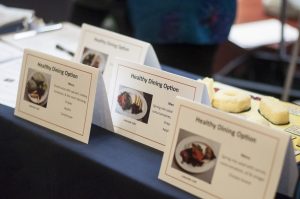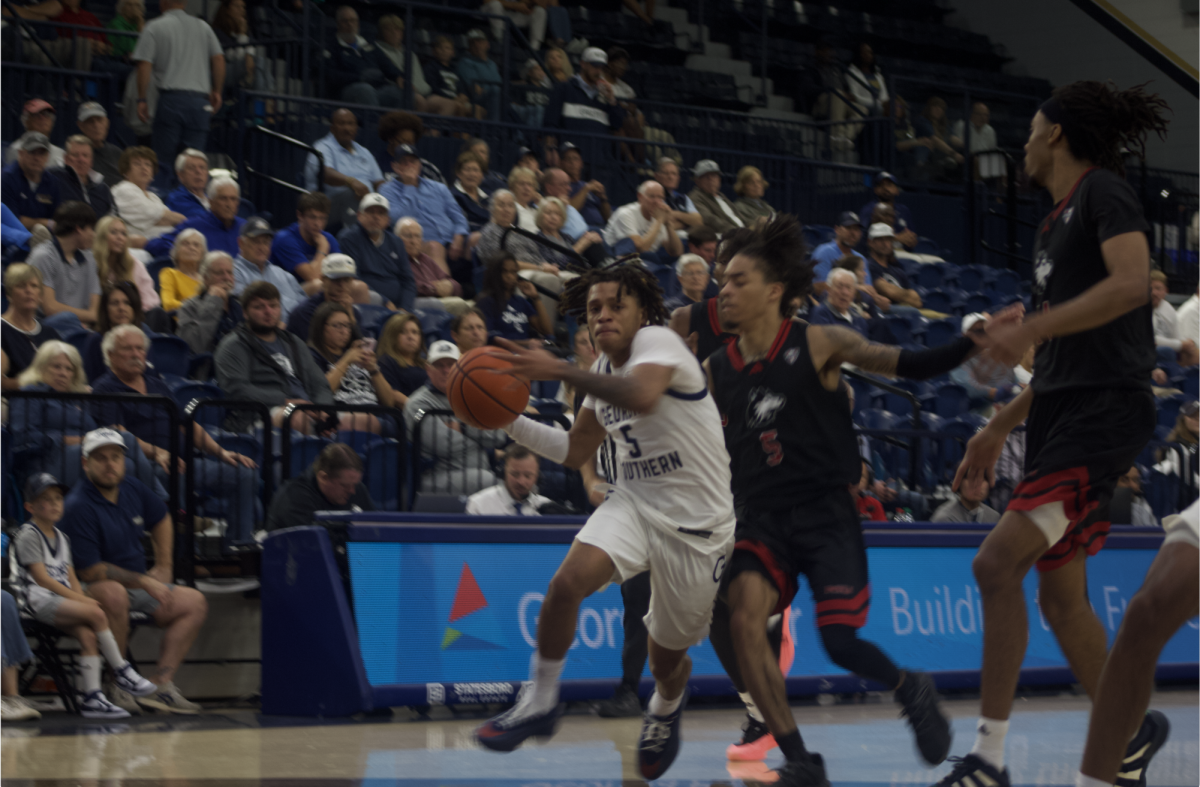What if you could choose foods that saved you calories and cash? Health Services hosted the “Save Calories and Cash” event in the Russell Union to let students know about solutions to students’ concerns about healthy foods and exercise. Many of these solutions were easy fixes for students to work into their diet, budget, and schedule.
Own Your Eating Habits
This was one of the bigger points stressed at the Save Calories and Cash event.
“A lot of times, students feel as if we don’t have healthy dining options within our healthy dining facilities when we actually do. It’s about whether or not you’re willing to take th e time to find that kind of food,” LaShanda Johnson, Assistant Director of Health Services, said.
e time to find that kind of food,” LaShanda Johnson, Assistant Director of Health Services, said.
Often times, people find it easier to go to, say, pizza, because it is already prepared, but healthy wraps and salads have to be built. To make these healthy options, you should know which foods are healthy versus which foods have secret calories or fats in them. How do you find that out, though?
“Make sure you’re educated about which foods are healthy versus which ones might have secret calories or secret fats placed into them. It’s always very accepting to ask the people who are producing the food how it’s produced, if it’s fried or if it’s baked,” Steven Waldrop, sophomore public health education and promotion major said.
Healthy options include foods you might expect, and some you might not consider eating.
In addition to fruits and veggies eaten by themselves, fruits and veggies can be mixed in with other meal options, such as a wrap or pasta. When eating grains, whole grains are usually a healthier bet. Whole grains are in breads and oatmeal, for example.
Other tips include what foods you should refrain from eating in large amounts. Students should not drink sugary beverages much. Calories from those drinks can add up quickly, and many of those calories add no nutritional value. As well, you should avoid always adding croutons, sauces, or bacon bits to their salads.
It can be more difficult for vegetarians to find suitable food options on campus and around town. At the dining halls, students who are vegetarians can add nuts and chickpeas to their salads, opt for soy milk, or grab a plate of pasta with marinara sauce. Other vegetarian food options include bean chili, bean burgers, vegetarian pizza, and vegetarian lasagna.
With many dishes, especially pasta, there are vegetarian alternatives. You just has to be on the lookout for them. When you’re at a restaurant, if there is not a specific vegetarian option available to order, you can often alter or substitute meat portions of a dish for something else.
Stay Active on Campus
Staying active on campus is easier than you think. Walking or biking to class is perhaps the easiest method, and you’re probably already doing it. Instead of taking the bus, try walking to a class.
For example, if you walk from the Russell Union to the College of Education, that is .87 of a mile. It is .67 of a mile to walk from Landrum to the nursing building if you walk down Forest Drive. Additionally, you can take the stairs in lieu of an elevator.
Also, spring is coming so you can join an intramural team to get more fit! Intramurals can be a great way to get exercise without having to be a pro at a sport, and you can join a team with friends. If you want to get more active, take advantage of the RAC and group fitness classes. The RAC offers a wide array of equipment and classes, so you can really customize what you want to get out of your workout routine.
Or there are adventure trips. Southern Adventures, through Campus Recreation and Intramurals, offers outdoor excursions including canoeing, rock climbing, hiking, and backpacking trips.
Buy & Cook Smarter, Not Harder
Stocking up your dorm with food can be expensive, but it doesn’t have to be. One of the best ways to avoid added expenses on groceries is to plan out what you need. Keep an eye out for coupons in student publications or in stores. Coupons can be helpful when there is a discount on items you were already planning on buying.
There are many foods which work well for dorm life. Examples include low-calorie cheese and pre-washed/pre-cut fruits and vegetables. These all can make great study or on-the-go snacks. Additionally, one can use cheese and eggs to make meals like scrambled eggs, omelets, and quesadillas, all from the convenience of a microwave.
For vegetarians, it is important to still consume minerals such as calcium. Calcium fortified soymilk, cereals, and orange juice are just some of the ways one can still get their daily recommended intake of calcium.
Also, students should make sure to buy in bulk and in-season. This usually equates to cheaper food. Cooking in the dorms is another way to save money make your own food. Cooking large batches of food or meals makes it easy to have leftovers, so students do not have to resort to take out meals throughout the week.
When you do have leftovers, make the most of them! Leftover meat, such as chicken, works great in stir fry or chicken chili. Just make sure that you use the leftovers, especially meats, before they go bad.
If you do eat out, go for ordering early bird specials or other deals. Often, it is cheaper to go out for lunch instead of dinner. Look for places like Applebee’s that offer their 2-for-20 deal and places that take Eagle Express or offer discounts for Georgia Southern students.
Being healthy on campus can be challenging. However, it’s not impossible. Choose My Plate offers more information on how to eat, buy, cook, and exercise smarter.
Photos by Kiara Griffin and Courtney Bonacci






